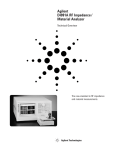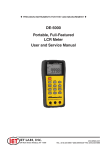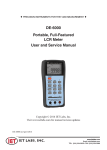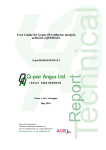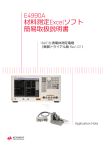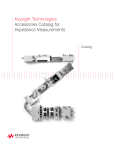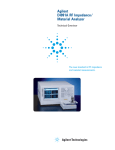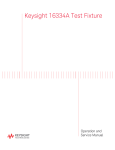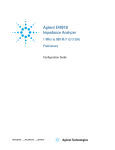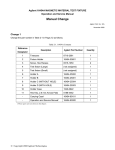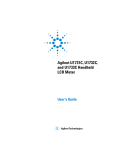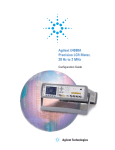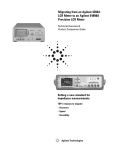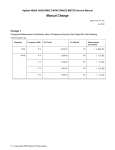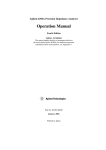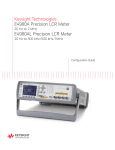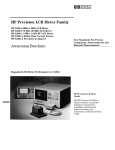Download Agilent Solutions for Measuring Permittivity and Permeability with
Transcript
Agilent Solutions for Measuring Permittivity and Permeability with LCR Meters and Impedance Analyzers Solutions for Measuring Permittivity and Permeability with LCR Meters and Impedance Analyzers Application Note 1369-1 1. 2. Introduction . . . . . . . . . . . . . . . . . . . . . . . . . . . . . . . . . . . . . . . . . . . . . . . . . . . . . . . . . . . . . . . . . . . . . . . . . . . . . . . . . . . . . . . . . . . . . . . 3 Permittivity Evaluation . . . . . . . . . . . . . . . . . . . . . . . . . . . . . . . . . . . . . . . . . . . . . . . . . . . . . . . . . . . . . . . . . . . . . . . . . . . . . . . . . . . . . . 4 2.1. Definition of permittivity. . . . . . . . . . . . . . . . . . . . . . . . . . . . . . . . . . . . . . . . . . . . . . . . . . . . . . . . . . . . . . . . . . . . . . . . . . . . . . . . . . . . . 4 2.2. Parallel plate measurement method . . . . . . . . . . . . . . . . . . . . . . . . . . . . . . . . . . . . . . . . . . . . . . . . . . . . . . . . . . . . . . . . . . . . . . . . . . . 5 2.3. Permittivity measurement system . . . . . . . . . . . . . . . . . . . . . . . . . . . . . . . . . . . . . . . . . . . . . . . . . . . . . . . . . . . . . . . . . . . . . . . . . . . . . 8 2.4. Measurement system using the 16451B dielectric test fixture. . . . . . . . . . . . . . . . . . . . . . . . . . . . . . . . . . . . . . . . . . . . . . . . . . . . . . 8 2.5. Measurement system using the 16453A dielectric test fixture. . . . . . . . . . . . . . . . . . . . . . . . . . . . . . . . . . . . . . . . . . . . . . . . . . . . . 13 3. Permeability Evaluation . . . . . . . . . . . . . . . . . . . . . . . . . . . . . . . . . . . . . . . . . . . . . . . . . . . . . . . . . . . . . . . . . . . . . . . . . . . . . . . . . . . . 17 3.1. Definition of permeability . . . . . . . . . . . . . . . . . . . . . . . . . . . . . . . . . . . . . . . . . . . . . . . . . . . . . . . . . . . . . . . . . . . . . . . . . . . . . . . . . . . 17 3.2. Inductance measurement method . . . . . . . . . . . . . . . . . . . . . . . . . . . . . . . . . . . . . . . . . . . . . . . . . . . . . . . . . . . . . . . . . . . . . . . . . . . 17 3.3. Permeability measurement system . . . . . . . . . . . . . . . . . . . . . . . . . . . . . . . . . . . . . . . . . . . . . . . . . . . . . . . . . . . . . . . . . . . . . . . . . . . 18 3.4. Measurement system using the 16454A magnetic material test fixture . . . . . . . . . . . . . . . . . . . . . . . . . . . . . . . . . . . . . . . . . . . . . 18 4. Conclusion. . . . . . . . . . . . . . . . . . . . . . . . . . . . . . . . . . . . . . . . . . . . . . . . . . . . . . . . . . . . . . . . . . . . . . . . . . . . . . . . . . . . . . . . . . . . . . . 20 Appendix . . . . . . . . . . . . . . . . . . . . . . . . . . . . . . . . . . . . . . . . . . . . . . . . . . . . . . . . . . . . . . . . . . . . . . . . . . . . . . . . . . . . . . . . . . . . . . . . . . . . . . . A. Permittivity Evaluation of Liquids . . . . . . . . . . . . . . . . . . . . . . . . . . . . . . . . . . . . . . . . . . . . . . . . . . . . . . . . . . . . . . . . . . . . . . . . . . . . A.1. Measurement system using the 16452A liquid test fixture . . . . . . . . . . . . . . . . . . . . . . . . . . . . . . . . . . . . . . . . . . . . . . . . . . . . . . . A.1.1. Main advantages . . . . . . . . . . . . . . . . . . . . . . . . . . . . . . . . . . . . . . . . . . . . . . . . . . . . . . . . . . . . . . . . . . . . . . . . . . . . . . . . . . . . A.1.2. Applicable MUT . . . . . . . . . . . . . . . . . . . . . . . . . . . . . . . . . . . . . . . . . . . . . . . . . . . . . . . . . . . . . . . . . . . . . . . . . . . . . . . . . . . . . A.1.3. Structure . . . . . . . . . . . . . . . . . . . . . . . . . . . . . . . . . . . . . . . . . . . . . . . . . . . . . . . . . . . . . . . . . . . . . . . . . . . . . . . . . . . . . . . . . . . A.1.4. Principal specifications . . . . . . . . . . . . . . . . . . . . . . . . . . . . . . . . . . . . . . . . . . . . . . . . . . . . . . . . . . . . . . . . . . . . . . . . . . . . . . . A.1.5. Operation method. . . . . . . . . . . . . . . . . . . . . . . . . . . . . . . . . . . . . . . . . . . . . . . . . . . . . . . . . . . . . . . . . . . . . . . . . . . . . . . . . . . . A.1.6. Special considerations. . . . . . . . . . . . . . . . . . . . . . . . . . . . . . . . . . . . . . . . . . . . . . . . . . . . . . . . . . . . . . . . . . . . . . . . . . . . . . . . 21 21 21 21 21 21 22 23 23 References . . . . . . . . . . . . . . . . . . . . . . . . . . . . . . . . . . . . . . . . . . . . . . . . . . . . . . . . . . . . . . . . . . . . . . . . . . . . . . . . . . . . . . . . . . . . . . . . . . . . . 24 2 1. Introduction Recently,electronicequipment technology has dramatically evolved to the point where an electronic component’s material characteristics becomes a key factor in a circuit’s behavior. For example, in the manufacture of high capacitance multilayer ceramic capacitors (MLCCs), which are being used more in digital (media) appliances, employing high κ (dielectric constant) material isrequired.Inaddition,various electrical performance evaluations, suchasfrequencyandtemperature response, must be performed before the materials are selected. Infieldsoutsideofelectronic equipment,evaluatingtheelectrical characteristics of materials has become increasingly popular. This is because composition and chemical variations of materials such as solids andliquidscanadoptelectrical characteristic responses as substituting performance parameters. A material evaluation measurement system is comprised of three main pieces. These elements include: precise measurement instruments, test fixtures that hold the material under test, and software that can calculate and display basic material parameters, such as permittivity and permeability. Various measurement methods for permittivity and permeability currently exist (see Table 1). However, this note’s primary focus will be on methods that employ impedance measurement technology, which have the following advantages: •Widefrequencyrangefrom20Hz to1GHz •Highmeasurementaccuracy •Simplepreparations(fabrication of material, measurement setup) for measurement This note begins by describing measurement methods, systems, and solutions for permittivity in Section2,followedbypermeability inSection3.Theresistivitymeasurement system and the permittivity measurementsystemforliquidsare described later in the appendix. Table 1. Measurement technology and methods for permittivity and permeability parameters Measurement parameter Measurement technology Impedance analysis Network analysis Permittivity Permeability Impedance analysis Network analysis Measurement method Parallel plate Reflection wave S parameters Cavity Free space Inductance Reflection wave S parameters Cavity 3 2. Permittivity Evaluation 2.1. Definition of permittivity Permittivity describes the interaction of a material with an electric field. Theprincipalequationsareshown in Figure 1. Dielectric constant (κ) isequivalenttothecomplexrelative permittivity (εr*) or the complex permittivity (ε*) relative to the permittivity of free space (ε0). The real part of complex relative permittivity (εr´) is a measure of how much energy from an external field is stored in a material; εr´ > 1 for most solidsandliquids.Theimaginary part of complex relative permittivity (εr´´) is called the loss factor and is a measure of how dissipative or lossy a material is to an external field. εr´´ isalways>0andisusuallymuch smaller than εr´. The loss factor includes the effects of both dielectric loss and conductivity. Whencomplexpermittivityisdrawn as a simple vector diagram as shown in Figure 1, the real and imaginary componentsare90°outofphase. The vector sum forms an angle δ with the real axis (εr´). The tangent of this angle, tan δ or loss tangent, is usually used to express the κ* = relative “lossiness” of a material. The term “dielectric constant” is often called “permittivity” in technical literature.Inthisapplicationnote, the term permittivity will be used to refer to dielectric constant and complex relative permittivity. * ε*r = εε0 = ε'r - j ε"r = (Real part) ε*r ε"r δ ε'r (Imaginary part) ε' - j ε0 ε" ε0 εr" (Imaginary) tan δ = ε ' (Real) r tan δ = D (Dissibation factor) κ* = Dielectic constant ε*r = Complex relative permitivity of 1 -9 [F/m] ε0 = Permitivity free space 36π X 10 Figure 1. Definition of relative complex permittivity (εr*) 4 2.2. Parallel plate measurement method of measuring permittivity Whenusinganimpedance-measuring instrument to measure permittivity, the parallel plate method is usually employed. An overview of the parallel platemethodisshowninFigure2. The parallel plate method, also called thethreeterminalmethodinASTM D150,involvessandwichingathin sheetofmaterialorliquidbetween two electrodes to form a capacitor. (Note: Throughout the remainder of this document materials under test, whether the material is a solid or a liquid,willbereferredtoasMUT.) The measured capacitance is then usedtocalculatepermittivity.Inan actual test setup, two electrodes are configured with a test fixture sandwiching dielectric material. The impedance-measuring instrument would measure vector components of capacitance (C) and dissipation (D) and a software program would calculate permittivity and loss tangent. The flow of the electrical field in an actual measurement is shown in Figure3.Whensimplymeasuring the dielectric material between two electrodes, stray capacitance or edge capacitance is formed on the edges oftheelectrodesandconsequently the measured capacitance is larger than the capacitance of the dielectric material. The edge capacitance causes a measurement error, since the current flows through the dielectric material and edge capacitor. Electrodes (Area = A) Equivalent circuit Y = G + jωCp = jωCo Cp G Co : Air capacitance G (CpCo – j ωCo ) εr' = ( At ** Cp εo) εr" = (ω * Rpt* A * ε ) o εr* Solid thickness = t G (CpCo – jωCo ) Liquid = Figure 2. Parallel plate method Guard electrodes Edge capacitance (stray) - + Electrical field - + Electrical field Figure 3. Effect of guard electrode A solution to the measurement error caused by edge capacitance is to use the guard electrode. The guard electrode absorbs the electric field at the edge and the capacitance that is measured between the electrodes is only composed of the current that flows through the dielectric material. Therefore, accurate measurements arepossible.Whenthemainelectrode is used with a guard electrode, the main electrode is called the guarded electrode. 5 Contacting electrode method: This method derives permittivity by measuring the capacitance of theelectrodescontactingtheMUT directly (see Figure 4). Permittivity and loss tangent are calculated using theequationsbelow: Cp: D: tm: A: d: ε0: Equivalent parallel capacitance of MUT [F] Dissipation factor (measured value) Average thickness of MUT [m] Guarded electrode’s surface area[m2] Guarded electrode’s diameter[m] Permittivity of free space = 8.854 x 10-12 [F/m] Equations: εr = tm x Cp tm x Cp = 2 A x ε0 π d2 x ε 0 tan δ = D The contacting electrode method requiresnomaterialpreparation and the operation involved when measuring is simple. Therefore, it is the most widely used method. However, a significant measurement error can occur if airgap and its effects are not considered when using this method. WhencontactingtheMUTdirectly with the electrodes, an airgap is formedbetweentheMUTandthe electrodes. No matter how flat and parallelbothsidesoftheMUTare fabricated, an airgap will still form. Guarded electrode Guard electrode d g tm MUT Unguarded electrode Figure 4. Contacting electrode method This airgap is the cause for measurement error because the measured capacitance will be the series connection of the capacitance of the dielectric material and the airgap. The relationship between the airgap’s thickness and measurement error is determinedbytheequationshownin Figure 5. A Co = εo t Capacitance of airgap a A Capacitance of dielectric material Cx = εx εo tm ta tm Cerr = Measured capacitance Measured error due to airgap 1- εerr εx 1 = 1 1 + Co Cx = εerr εo t A m + ta εx - 1 t εx + tma Figure 5. Airgap effects Table 2. Measurement error caused by airgap ta /tm 0.001 0.005 0.01 0.05 0.1 εr’ 2 5 10 20 50 100 0.1% 0.5% 1% 5% 8% 0.4% 2% 4% 16% 27% 1% 4% 8% 30% 45% 2% 9% 16% 48% 63% 5% 20% 33% 70% 82% 9% 33% 50% 83% 90% This airgap effect can be eliminated, by applying thin film electrodes to the surfaces of the dielectric material. 6 Measurement error is a function of the relative permittivity (εr´) of the MUT,thicknessoftheMUT(tm), and the airgap’s thickness (ta).Sample results of measurement error have beencalculatedinTable2.Notice that the effect is greater with thin materials and high κ materials. Anextrastepisrequiredformaterial preparation (fabricating a thin film electrode), but the most accurate measurements can be performed. Non-contacting electrode method Thismethodwasconceptualized to incorporate the advantages and exclude the disadvantages of the contactingelectrodemethod.It doesnotrequirethinfilmelectrodes, but still solves the airgap effect. Permittivity is derived by using the results of two capacitance measurementsobtainedwiththeMUTand without it (Figure 6). Cs1: Capacitance without MUT inserted[F] Cs2: Capacitance with MUT inserted[F] D1: Dissipation factor without MUT inserted D2: Dissipation factor with MUT inserted tg : Gap between guarded/guard electrode and unguarded electrode [m] tm: Average thickness of MUT [m] Theoretically, the electrode gap (tg) should be a little bit larger than the thicknessoftheMUT(tm).Inother words, the airgap (tg – tm) should be extremely small when compared to thethicknessoftheMUT(tm). These requirementsarenecessaryforthe measurement to be performed appropriately. Two capacitance measurements are necessary, and the results are used to calculate permittivity.Theequationisshown at right. Equations: ' εr = 1 t C 1− 1− s1 x g Cs2 tm tan δ = D2 + εr ' x (D2 − D1) x tg −1 (when tan δ <<1) tm Guarded electrode Guard electrode g d MUT tg tm Unguarded electrode Figure 6. Non-contacting electrode method Table 3. Comparison of parallel plate measurement methods Method Contacting electrode (without thin film electrode) Non-contacting electrode Contacting electrode (with thin film electrode) Accuracy LOW MEDIUM HIGH Application MUT Solid material with a flat and smooth surface Solid material with a flat and smooth surface Thin film electrode must be applied onto surfaces Operation 1 measurement 2 measurements 1 measurement 7 2.3. Permittivity measurement system Two measurement systems that employ the parallel plate method will be discussed here. The first is the 16451B dielectric test fixture, which has capabilities to measure solidmaterialsupto30MHz.The latteristhe16453Adielectricmaterial test fixture, which has capabilities to measure solid materials up to1GHz.Detailsofmeasurement systems described in this note will follow the subheadings outlined below: 1) 2) 3) 4) 5) 6) 7) Main advantages Applicable MUT Structure Principal specifications Operation method Special considerations Sample measurements 2.4. Measurement system using the 16451B dielectric test fixture 2.4.1. Main advantages •Precisemeasurementsarepossible inthefrequencyrangeupto30MHz •Fourelectrodes(AtoD)are provided to accommodate the contacting and non-contacting electrode methods and various MUTsizes •Guardelectrodetoeliminatethe effect of edge capacitance •Attachmentsimplifiesopenand short compensation •Canbeusedwithanyimpedancemeasuring instrument with a 4-terminal pair configuration 8 Applicable measurement instruments: E4990A, 4285A, E4980A, and E4981A 2.4.2. Applicable MUT The applicable dielectric material is a solid sheet that is smooth and hasequalthicknessfromoneendto the other. The applicable dielectric material’ssizeisdeterminedby the measurement method and type of electrode to be used. Electrodes A and B are used for the contacting electrode method without the fabrication of thin film electrodes. Electrodes C and D are used for the contacting electrode method with the fabrication of thin film electrodes.Whenemployingthe non-contacting electrode method, electrodesAandBareused.Inthis method, it is recommended to process the dielectric material to a thickness of a few millimeters. The difference between electrodes A and B is the diameter (the same difference applies to electrodes C and D). Electrodes A and C are adaptedforlargeMUTsizes,and electrodes B and D are adapted for smallerMUTsizes.Theapplicable MUTsizesforeachelectrodeare shown in Tables 4 and 5. The dimensions of each electrode are showninFigures7through10. Table 4. Applicable MUT sizes for electrodes A and B Electrode type A B Material diameter 40 mm to 56 mm 10 mm to 56 mm Material thickness t ≤ 10 mm t ≤ 10 mm Electrode diameter 38 mm 5 mm Electrode-A Electrode-B ∅38 0.2 ∅5 0.13 ∅56 ∅20 Test material Test material ≤ 10 ≤ 10 40 to 56 10 to 56 Note: ∅ signifies diameter. Dimensions are in millimeters. Note: ∅ signifies diameter. Dimensions are in millimeters. Figure 7. Electrode A dimensions Figure 8. Electrode B dimensions Table 5. Applicable MUT sizes for electrodes C and D Electrode type C D Material diameter 56 mm 20 mm to 56 mm Material thickness t ≤ 10 mm t ≤ 10 mm Electrode diameter* 5 to 50 mm 5 to 14 mm ∅7 ∅7 Electrode-C Electrode-D ∅52 ∅56 Guard thin film electrode ∅16 ∅20 Guarded thin film electrode Test material Test material 5 to 50 ≤ 52 The gap width shall be as small as practical 5 to 14 ≤ 16 The gap width shall be as small as practical ≤ 10 56 Note: ∅ signifies diameter. Dimensions are in millimeters. Figure 9. Electrode C dimensions ≤ 10 20 to 50 Note: ∅ signifies diameter. Dimensions are in millimeters. Figure 10. Electrode D dimensions *Diameter of applied thin film electrodes on surfaces of dielectric material 9 2.4.3. Structure Inordertoeliminatethemeasurement error caused by edge capacitance, a three-terminal configuration (including a guard terminal) is employed. The structure of the 16451B is shown in Figure 11. Guard terminal Unguarded electrode Guarded electrode Hcur Hpot Lput Lcur The electrodes in the 16451B are made up of the following: The guard electrode encompasses the guarded (or main) electrode and absorbs the electric field at the edge of the electrodes, making accurate permittivity measurements possible. Figure 11. Structure of the 16451B Δ ε r' / ε r' [%] 1. Unguardedelectrode,whichis connected to the measurement instrument’s high terminal. 2. Guardedelectrode,whichis connected to the measurement instrument’s low terminal. 3. Guardelectrode,whichis connected to the measurement instrument’s guard terminal (the outer conductor of the BNC connectors). 4-terminal pair Electrode A: 50 45 40 35 30 25 20 15 10 5 0 t = 1 [mm] er = 50 er = 20 er = 10 er = 5 er = 2 40 100 1k 10 k 100 k 1M 10 M 30 M Frequency [Hz] 2.4.4. Principal specifications Figure 12. Permittivity measurement accuracy (supplemental data) Table 6. Principal specifications of the 16451B ≤ 30 MHz ±42 V 0 °C to 55 °C 4-terminal pair, BNC 1m Open/short* The principal specifications are shown inTable6.Figures12and13show the measurement accuracy when Agilent’sE4990Aisused.Further details about the measurement accuracy can be obtained from the Accessories Selection Guide for Impedance Measurements (literaturenumber5965-4792E) Electrode A: 10 tan δ error (Ea) Frequency Max voltage Operation temperature Terminal configuration Cable length Compensation t = 1 [mm] 1 er = 50 er = 20 er = 10 er = 5 er = 2 0.1 0.01 0.001 40 100 1k 10 k 100 k 1M 10 M 30 M Frequency [Hz] Figure 13. Loss tangent measurement accuracy (supplemental data) *When using the 4285A or E4990A above 5 MHz, it is necessary to perform load compensation in addition to open and short compensation. For more details, please refer to Section 2.4.5 Operation method. 10 2.4.5. Operation method Figure 14 displays the flowchart when using the 16451B for permittivity measurements. Each step in the flowchart is described here: Step 1. Prepare the dielectric material: FabricatetheMUTtotheappropriate size.UseFigures7through10as references.Ifthecontactingelectrode method with thin film electrodes is employed, apply thin film electrodes tothesurfacesoftheMUT. Step 2. Attach the guarded electrode: Selecttheappropriateelectrodeand fit it into the 16451B. Step 3. Connect the 16451B: Connect the 16451B to the unknown terminals of the measurement instrument. Step 4. Cable length compensation: Setthemeasurementinstrument’s cable length compensation function to 1 m. Refer to the measurement instrument’s operation manual for the setting procedure. Step 5. Compensate the residual impedanceofthe16451B:Usethe furnished attachment to perform open and short compensation at a specifiedfrequency.Thisisnecessary before adjusting the guarded and unguarded electrodes to be parallel to each other. Step 6. Adjust the electrodes: To enhance the measurement performance, a mechanism is provided to adjust the guarded and unguarded electrodes to be parallel to each other. By performing this adjustment, the occurrence of the airgap when using the contacting electrode method is minimizedandanairgapwithuniform thickness is created when using the non-contacting electrode method. The adjustment procedure is discussed in the operation manual of the 16451B. Step 8. Compensate the residual impedanceofthe16451B:Usethe furnished attachment to perform open and short compensation of the measurement conditions set in Step7. WhenusingtheAgilent4285Aor E4990Aabove5MHz,itisnecessary to perform load compensation also. Thisisbecauseforhighfrequency measurements, it is difficult to disregard the residual impedance, which cannot be removed by open and short compensation. Inordertocompensatethefrequency response of the 16451B, a measured valueat100kHzisusedasastandard value and load compensation is performedathighfrequencies.The air capacitance formed by creating an airgap between the electrodes (with nothing inserted) is adopted as the load device for the 16451B. Table 7 lists the recommended capacitance values that are obtained by adjusting the height of the airgapbetweentheelectrodes.Itis assumed that the air capacitance hasnofrequencydependency,no loss and has a flat response. The capacitancevalue(Cp)at100kHz (Gisassumedtobezero)isused for load compensation. Step 9.InsertMUT:InserttheMUT between the electrodes. Step 10. Cp-D measurement: The capacitance (Cp) and dissipation factor(D)ismeasured.Whenemploying the non-contacting electrode method, two Cp-D measurements are performed,withandwithouttheMUT. Step 11. Calculate permittivity: As previouslydiscussedinSection2.2, usetheappropriateequationto calculate permittivity. START 1. Prepare the dielectric material 2. Attach the guarded electrode 3. Connect the 16451B 4. Cable length compensation 5. Compensation for adjustment of electrodes 6. Adjust the electrodes 7. Set the measurement conditions 8. Compensate the residual impedance 9. Insert the MUT 10. Cp-D measurement 11. Calculate permittivity END Figure 14. Measurement procedure flowchart for the 16451B Table 7. Load values Electrode A B C, D Recommended capacitance* 50 pF ± 0.5 pF 5 pF ± 0.05 pF 1.5 pF ± 0.05 pF * Measured Cp value at 100 kHz Step 7.Setthemeasurementconditions: Measurement conditions such asfrequencyandtestvoltagelevel are set on the measurement instrument. Refer to the measurement instrument’s operation manual for the setting procedure. 11 2.4.6 Special considerations As mentioned before, to reduce the effect of the airgap, which occurs betweentheMUTandtheelectrodes, it is practical to employ the contacting electrode method with thin film electrodes(RefertoSection2.2). Electrodes C and D are provided with the 16451B to carry out this method. Materials under test that transform under applied pressure cannot keep afixedthickness.ThistypeofMUT is not suitable for the contacting electrodemethod.Instead,the non-contacting method should be employed. Whenthenon-contactingmethod is employed, the electrode gap tg is requiredtobeatmost10%larger thanthethicknessoftheMUT.Itis extremelydifficulttocreatea10% electrode gap with thin film materials. Therefore, it is recommended that only materials thicker than a few millimeters be used with this method. The micrometer on the 16451B is designed to make a precise gap when using the non-contacting electrode method. Accurate measurements of thethicknessofMUTcannotbemade, when employing the contacting electrode method. This is because the micrometer scale is very dependent upon the guard and the unguarded electrodesbeingparallel.Usinga separate micrometer for measuring thickness is recommended. 12 2.5. Measurement system using the 16453A dielectric material test fixture 2.5.1. Main advantages • Widefrequencyrangefrom 1MHz–1GHz • OptionE4991B-002(material measurement software) internal firmware in the E4991B solves edge capacitance effect • Open,shortandloadcompensation • Directreadoutsofcomplex permittivity are possible with theOptionE4991B-002(material measurement software) internal firmware in the E4991B. • Temperaturecharacteristics measurements are possible from–55°Cto+150°C(with OptionsE4991B-002and E4991B-007). * For temperature-response evaluation, Option E4991B-007 temperature characteristic test kit is required. A Microsoft Excel VBA sample program is pre-installed in the E4991B that provides chamber control and measurement setup functions. The sample program can be copied to an external PC. Applicable measurement instruments: E4991B (Option E4991B-002)* 2.5.2. Applicable MUT d The applicable dielectric material is a solid sheet that is smooth and has equalthicknessfromoneendtothe other.TheapplicableMUTsizeis shown in Figure 15. t 2.5.3. Structure Thestructureofthe16453Acanbe viewed in Figure 16. The upper electrode has an internal spring, which allowstheMUTtobefastened between the electrodes. Applied pressure can be adjusted as well. The16453Aisnotequippedwith a guard electrode like the 16451B. This is because a guard electrode at highfrequencyonlycausesgreater residual impedance and poor frequencycharacteristics.Tolessen the effect of edge capacitance, a correction function based on simulation results is used in the E4991B, OptionE4991B-002(material measurement) firmware. Also, residual impedance, which is a major cause for measurement error, cannot be entirely removed by open and short compensation. This is why PTFE is provided as a load compensation device. t d ≥ 15 mm 0.3 mm ≤ t ≤ 3 mm Figure 15. Applicable MUT size Upper electrode spring Diameter is 10 mm MUT 16453A Diameter is 7 mm Lower electrode Figure 16. Structure of the 16453A 13 2.5.4. Principal specifications Table 8. Principal specifications of the 16453A Frequency Max. voltage Operating temperature Terminal configuration Compensation 1 MHz to 1 GHz ±42 V -55 °C to +150 °C* 7 mm Open, short and load * Must be accompanied by the E4991B with Options E4991B-002 and E4991B-007. The principal specifications are shown inTable8.Figures17and18show the measurement accuracy when the E4991B is used. Further details about the measurement accuracy can be obtained from the operation manual supplied with the instrument. Figure 17. Permittivity measurement accuracy (supplemental data) 2.5.5. Operation method Figure 19 displays the flowchart whenusingthe16453AandE4991B for permittivity measurements. The steps in the flowchart are described here. For further details, please refer to the Quick Start Guide for the E4991B. START 1. Select the measurement mode Figure 18. Loss tangent measurement accuracy (supplemental data) 2. Input thickness of MUT 3. Set the measurement conditions Step 1.Selectthemeasurement mode:Selectpermittivitymeasurement in E4991B’s utility menu. 4. Connect the 16453A 5. Input thickness of load device Step 2.InputthethicknessofMUT: EnterthethicknessoftheMUTinto theE4991B.Useamicrometerto measure the thickness. Step 5.Inputthethicknessofload device: Before compensation, enter the furnished load device’s (PTFE board) thickness into the E4991B Step 6. Calibrate the measurement plane: Perform open, short, and load calibration. 6. Calibrate the measurement plane 7. Insert the MUT 8. Measure the MUT END Figure 19. Measurement procedure flowchart for the 16453A 14 Step 3.Setthemeasurementconditions of the E4991B: Measurement conditionssuchasfrequency,test voltage level, and measurement parameter are set on the measurement instrument. Step 4.Connectthe16453A:Connect the16453Atothe7mmterminalof the E4991B. Step 7.InsertMUT:InserttheMUT between the electrodes. Step 8.MeasuretheMUT:Themeasurement result will appear on the display.Thedatacanbeanalyzed using the marker functions. 2.5.6 Special considerations As with the previous measurement system, an airgap, which is formed betweentheMUTandtheelectrodes, can be a primary cause of measurement error. Thin materials and high k materials are most prone to this effect. Materials with rough surfaces (Figure20)canbesimilarlyaffected by airgap. t2 t1 t 2 > t1 Cut-out for the positioning of the thin film electrode. φ7 Electrode Back Dielectric material φ 10 Electrode Airgap Front φ2 Electrode 24.5 13 MUT 6 9.9 25.1 25.1 9.9 70 Electrode Unit: mm Figure 21. Fabricated thin film electrode’s size Figure 20. Rough-surfaced dielectric material Thereisatechniquetoapplya thin film electrode onto the surfaces of the dielectric material in order to eliminate the airgap that occurs betweentheMUTandtheelectrodes. ThistechniqueisshowninFigure21 and22Anelectrodetheexactshape andsizetofitthe16453Aisfabricated onto the dielectric material using either high-conductivity silver pastes orfired-onsilver.TheMUTshould beshapedasinFigure21,withthe thin film electrode thinner than the dielectricmaterial.Inthiscase,itis vital to appropriately position the fabricated thin film electrode onto theMUT,topreciselycontactthe electrodesofthe16453A(Figure22). Following this process will ensure a more accurate and reliable measurement. Inaddition,iftheMUTsareverythin, forexamplecloseto100 µm, it is possibletostack3or4otherMUTs and then make the measurement. This will reduce the airgap and increase measurement precision. TheMUTmustbesmoothandnot transform under applied pressure. Figure 22. Positioning of the fabricated thin film on the MUT Another point to consider is the adjusting mechanism of the upper electrode’s spring pressure. The spring’s pressure should be as strong as possible in order to minimizetheoccurrenceofthe airgapbetweentheMUTandthe electrodes. However, MUTswhich transform under extreme pressure, cannot be measured correctly, since the thickness is affected. To achieve stable measurements, the spring pressure should be set at a level that doesnottransformtheMUT. 15 2.5.7. Sample measurements AsshowninFigure23,ameasurementresultforglassepoxyfrequency characteristic can be obtained by usingtheE4991Bwiththe16453A. Figure 23. Frequency response of glass epoxy (εr = 4.5) 16 3. Permeability Evaluation 3.1. Definition of permeability Permeability describes the interaction of a material with a magnetic field. Itistheratioofinduction,B,tothe appliedmagnetizingfield,H.Complex relative permeability (µr*) consists of the real part (µr’) that represents the energy storage term and the imaginary part (µr”) that represents thepowerdissipationterm.Itisalso the complex permeability (µ*) relative to the permeability of free space (µ0) asshowninFigure24. The inefficiency of magnetic material is expressed using the loss tangent, tan δ. The tan δ is the ratio of (µr”) to (µr’). The term “complex relative permeability” is simply called “permeability” in technical literature. Inthisapplicationnote,theterm permeability will be used to refer to complex relative permeability. 3.2. Inductance measurement method Relative permeability of magnetic material derived from the self-inductance of a cored inductor that has a closed loop (such as the toroidal core) is often called effective permeability. The conventional method of measuring effective permeability is to wind some wire around the core and evaluate the inductance with respect to the ends of the wire. This type of measurement is usually performed with an impedance measuring instrument. Effective permeability is derived from the inductance measurement result using the following equations: ' μe = " μe = μ* μ* r = μ0 = μ'r - j μ "r = (real part) (imaginary part) μ' -j μ0 B μ*r μ" r δ μ'r H tan δ = μ* = μ" μ0 μr" (imaginary) μr' (real) μ*r = Complex relative permeability B H μ0 = Permeability of free space 4π X 10-7 [H/m] Figure 24. Definition of complex permeability (m*) Reff: Leff: Rw: Lw: N: : A: ω: µ0: Depending on the applied magnetic field and where the measurement is located on the hysteresis curve, permeability can be classified in degree categories such as initial or maximum.Initialpermeabilityis the most commonly used parameter among manufacturers because most industrial applications involving magnetic material use low power levels.* Equivalent resistance of magnetic core loss including wire resistance Inductance of toroidal coil Resistance of wire only Inductance of air-core coil inductance Turns Average magnetic path length of toroidal core [m] Cross-sectional area of toroidal core [m2] 2π f (frequency) 4π x 10-7 [H/m] This application note focuses on effective permeability and initial permeability, derived from the inductance measurement method. Equivalent circuit Lw Rw Leff Reff L eff μ0 N 2 A ( Reff – Rw ) μ0 N 2 ω A Figure 25. Method of measuring effective permeability * Some manufacturers use initial permeability even for magnetic materials that are employed at high power levels. 17 3.3. Permeability measurement system The next section demonstrates a permeability measurement system using the 16454A magnetic material test fixture. 3.4. Measurement system using the 16454A magnetic material test fixture 3.4.1. Main advantages • Widefrequencyrangefrom1kHz to1GHz • Simplemeasurementswithout needing a wire wound around the toroid • Twofixtureassembliesare providedfordifferentMUTsizes • Directreadoutsofcomplex permeability are possible with theE4991B(OptionE4991B-002 material measurement software) orwiththeE4990A. Applicable instruments: E4991B (Option E4991B-002)*, E4990A, and 42942A • Temperaturecharacteristic measurements are possible from –55°Cto+150°C(withthe E4991BOptionsE4991B-002and E4991B-007) ≤ 8 mm ≤ 20 mm ≥ 3.1 mm ≥ 5 mm ≤ 8.5 mm ≤ 3 mm 3.4.2. Applicable MUT Small size * For temperature-response evaluation, Option E4991B-007 temperature characteristic test kit is required. A Microsoft Excel VBA sample program is pre-installed in the E4991B that provides chamber control and measurement setup functions. The sample program can be copied to an external PC. The E4990A does not have a high temperature test head. The applicable magnetic material can only be a toroidal core. The applicableMUTsizeisshownin Figure26. Large size Figure 26. Applicable MUT size single-turn inductor, with no flux leakage, is formed. Permeability is derived from the inductance of the toroidal core with the fixture. 3.4.3. Structure The structure of the 16454A and the measurement concept are shown in Figure27.Whenatoroidalcoreis inserted into the 16454A, an ideal, • • µ= c c +1 b b • µ • E4991B/E4990A Relative permeability Zm Measured impedance with toroidal core Zsm Measured impedance without toroidal core • µ0 Permeability of free space h c b Height of MUT (material under test) Outer diameter of MUT Inner diameter of MUT Figure 27. Structure of the 16454A and measurement concept 18 • (Zm− Zsm) 2π jωµ0 h ln 3.4.4. Principal specifications 5% h In 3000 Table 9. Principal specifications of the 16454A 2500 1 kHz to 1 GHz ±500 mA -55 °C to +150 °C 7 mm Short 2000 μr' Frequency Max dc bias current Operating temperature Terminal configuration Compensation Step 2. Connect the 16454A: Connect 10% 1000 500 20% 20% 0 1k 10k 100k 1M 10M Frequency [Hz] 10M 1G Figure 28. Permeability measurement accuracy (supplemental data) Figure30displaystheflowchartwhen using the 16454A for permeability measurements. Each step of the flowchart is described here: h In 1.00 E+01 C = 10 [mm] b 1.00 E+00 tan δ error (Ea) Step 1. Calibrate the measurement instrument:WhenusingtheE4991B, calibrate at the 7 mm terminal. WhenusingtheE4990A,perform SETUPonthe7mmterminal of the 42942A. 2500 10% Principal specifications of the 16454A are shown in Table 9 above. Figures28and29showthemeasurement accuracy when either the E4991BortheE4990Aareused. 3.4.5. Operation method C = 10 [mm] b μ'r =300 .00 E+00 μ'r =100 μ'r =1000 μ'r =3 μ'r =10 .00 E+00 μ'r =3000 .00 E+00 1k μ'r =30 10k 100k 1M 10M Frequency [Hz] 100M the 16454A to the measurement instrument’s7mmterminal.When using the E4991B, select the permeability measurement mode. Figure 29. Loss tangent measurement accuracy (supplemental data) Step 3. Compensate the residual Step 7.MeasuretheMUT:The measurement result will appear on thedisplay.Thedatacanbeanalyzed using the marker functions. impedanceofthe16454A:Insert onlytheMUTholderandperform short compensation. Step 4.InputsizeofMUT:Enterthe sizeoftheMUTintothemeasurement instrument’smenu.Useamicrometer tomeasurethesize. Step 5.InsertMUT:InserttheMUT with the holder into the 16454A. Step 6.Setthemeasurementconditions: Measurement conditions such asfrequency,testsignallevel,and measurement parameter are set on the measurement instrument. Internalfirmwarecomesstandard with the material measurement function when using the E4991B (Option E4991B-002).Formore details, refer to the Operation Manual of the E4991B. 1G START 1. Calibrate the instrument 2. Connect the 16454A 3. Compensate the residual impedance 4. Input the size of the MUT 5. Insert the MUT 6. Set the measurement conditions 7. Measure the MUT END Figure 30. Measurement procedure flowchart for the 16454A 19 3.4.6. Special considerations Whenmeasuringamagneticmaterial with a high permittivity (near 10orabove),precisemeasurements cannotbeperformednear1GHz. Permeability is derived from the inductance value of the combined impedanceoftheMUTandthe fixture. The measured impedance should be composed of inductance and a negligible amount of capacitance.Whenthemagneticmaterial’s permittivity is high, current flows throughthespacebetweentheMUT andthefixture.Thisisequivalent to a capacitor connected in paralleltotheinductor(oftheMUT). This parallel LC circuit causes an impedance-resonance at a destined frequency.Thehigherthepermittivity,thelowertheresonantfrequency will be and precise measurements will be difficult. 3.4.7. Sample measurements Frequencycharacteristicmeasurement results of a ferrite core are showninFigure31.TheE4991Band the 16454A were used to obtain the resultsinFigure31. 4. Conclusion Inthisapplicationnote,permittivity and permeability measurement methods using impedance measurement technology were discussed. The discussions covered various test fixtures’ structures, applicable MUTsizes,operationmethodsand special considerations. By using this application note as a reference, a measurement solution that satisfies measurement needs and conditions can be selected easily. 20 Figure 31. Frequency response of ferrite core (µr = 120) Appendix A. Permittivity Evaluation of Liquids be washed. Nickel is used for the electrodes,spacers,liquidinletand outlet and fluoro-rubber is used for theO-rings. Permittivity measurements are oftenusedforevaluationofliquid characteristics. Permittivity measurementsdonotchangetheliquid physically and can be conducted rathersimplyandquickly.Asa result,theyareutilizedinawide array of research areas. Here, the 16452Aliquidtestfixture,which employs the parallel plate method, will be discussed as a permittivity measurementsystemforliquids. A.1. Measurement system using the 16452A liquid test fixture Applicable instruments: E4990A and E4980A A.1.1. Main advantages Table 10. Relationship between spacers and liquid capacity • Widefrequencyrangefrom20Hz to30MHz • Plasticresins,oil-basedchemical products and more can be measured • Measurementispossiblewitha smallvolumeoftestliquidso MUTisnotwasted • Temperaturecharacteristic measurements are possible from –20°Cto+125°C • Canbeusedwithanyimpedance measuring instrument that has a 4-terminal configuration. A.1.2. Applicable MUT Thesampleliquidcapacityisdependent upon which spacer is used. The spacer adjusts the gap between the electrodes and causes the air capacitancetobealteredaswell.Table10 lists the available spacers and the correspondingsampleliquid capacities. A.1.3. Structure Thestructureofthe16452Ais showninFigure32.Threeliquid inlets simplify pouring and draining and the fixture can be easily disassembled so that the electrodes can Sample liquid capacity Air capacitance (no liquid present) Spacer thickness 37 mm 3.4 ml 34.9 pF ±25% 1.3 mm 4.8 ml 10.9 pF ±10% 2 mm 6.8 ml 5.5 pF ±10% 3 mm 85 mm SMA SMA S Ceramic 3.8 ml 21.2 pF ±15% 1.5 mm 85 mm Ceramic Lo Hi Spacer Figure 32. Structure of the 16452A A1mcableisrequiredforconnecting to the measurement instrument. Appropriate cables are listed in Table 11. Table 11. 1 m cables for the 16452A Temperature 0 °C to 55 °C -20 °C to 125 °C -20 °C to 125 °C Part number 16048A 16452-61601 16048G (E4990A only) 21 A.1.4. Principal specifications Table 12. Principal specifications of the 16452A 25% 20 Hz to 30 MHz ± 42 V -20 °C to 125 °C 4-terminal pair, SMA Short The principal specifications of the 16452AareshowninTable12and the measurement error is calculated usingthefollowingequation. 15% 10% 10.0% 5.0% Error B Frequency Max voltage Operating temperatures Terminal configuration Compensation 2.0% 1.0% 1.0% 0.2% 0.15% Measurement accuracy = A + B + C [%] Error A: see Table 13 Error B: when εr’= 1; see Figure 33 Error C: error of measurement instrument B (%) M.R.P is measurement relative permittivity 22 500k 20 100 1k 10k 100k Frequency [Hz] Figure 33. Relative measurement accuracy (supplemental data) Table 13. Error A Spacer thickness (mm) 1.3 0.005 x MRP 1.5 0.006 x MRP 2.0 0.008 x MRP 3.0 0.020 x MRP 0.1% 2M 1M 5M 15M 20M 10M 30M A.1.5. Operation method Figure34displaystheflowchartwhen usingthe16452Aforpermittivity measurementsofliquids.Eachstep of the flowchart is described here: Step 1.Assemblethe16452Aand inserttheshortingplate:While attaching the high and low electrodes, insert the shorting plate between them. Next, prepare the 16452AformeasurementbyconnectingtheSMA-BNCadaptersto the terminals of the fixture and puttingthelidontheliquidoutlet. Step 7. Measure the air capacitance: Remove the shorting plate, and insert theappropriatespacerrequired forthesampleliquidvolume.The air capacitance that exists between the electrodes is measured with the parameter Cp-Rp. 2. Connect the 16452A 3. Cable length compensation Step 9.Measureliquid:Performa Cp-Rpmeasurementwiththeliquid in the fixture. Step 10. Calculate permittivity: Permittivity and loss factor is calculatedusingthefollowingequations: Step 3. Compensate the cable length: Setthemeasurementinstrument’s cable length compensation function to 1 m. Refer to the measurement instrument’s operation manual for the setting procedure. Cp: Step 5.Setthemeasurement conditions: Measurement conditions suchasfrequencyandtestvoltage level are set on the measurement instrument. The measurement parameter should be set to Cp-Rp. Refer to the measurement instrument’s operation manual for the setting procedure. Step 6. Perform short compensation: Perform short compensation with the shorting plate inserted between the electrodes. 1. Assemble the 16452A and insert the shorting plate Step 8.Pourliquidin:Pourtheliquid into the inlet of the fixture. Step 2.Connectthe16452Atothe measurementinstrument:Selectthe appropriate 1 m cable depending on the operating temperature and the measurement instrument. Connect the 16452AtotheUNKNOWNterminals of the measurement instrument. Step 4. Check the short residual of the16452A:Toverifywhetherthe 16452Awasassembledproperly, measuretheshortingplateat1MHz and check if the value falls within the prescribed range. Perform this verification before short compensation. For further details, refer to the Operation Manual provided with the16452A. START ' εr = Cp C0 " εr = 1 ω C0 Rp 4. Check the short residual 5. Set the measurement conditions 6. Perform short compensation 7. Measure the air capacitance 8. Pour the liquid in C0: Rp: ω: Equivalent parallel capacitance of MUT [F] Equivalent parallel capacitance of air [F] Equivalent parallel resistance of MUT [Ω] 2 π f (frequency) Step 11.Drainliquidout:Drainthe liquidoutfromtheoutletofthe fixture. A.1.6. Special considerations 9. Measure the liquid 10. Calculate permittivity 11. Drain the liquid END Figure 34. Measurement procedure flowchart for the 16452A Thereisahighpossibilitythatliquids with bulk conductivity such as salt (Na+Cl-)orionicsolutionscannot be measured. This is due to the electrodepolarizationphenomenon, which causes incorrect capacitance measurements to occur for these typesofliquids.Evenforlow frequencymeasurementsofliquids that do not have bulk conductivity, such as water, there is a high possibilitythatelectrodepolarization will occur. 23 References 1.ASTM,“Test methods for A-C loss characteristics and permittivity (dielectric constant) of solid electrical insulating materials,”ASTM StandardD150,AmericanSocietyforTestingandMaterials 2. ASTM,“Test methods for D-C resistance or conductance of insulating materials,”ASTMStandardD257,AmericanSocietyforTestingand Materials 3.Application Note 1297, “Solutions for measuring permittivity and permeability,”Agilentliteraturenumber5965-9430E 4. Application Note 380-1, “Dielectric constant measurement of solid materials using the 16451B dielectric test fixture,” Agilent literaturenumber5950-2390 5. Accessories Selection Guide for Impedance Measurements, Agilent literaturenumber5965-4792E 6. Agilent 16451B Operation and Service Manual,PN16451-90020 7. Agilent 16452A Operation and Service Manual,PN16452-90000 8. Agilent 16454A Operation and Service Manual,PN16454-90020 24 www.agilent.com Web resources Please visit our website at: www.agilent.com/find/impedance for more information about impedance test solutions, www.agilent.com/find/lcrmeters for more information about lcr meters. For more information about material analysis visit: www.agilent.com/find/materials For more information on Agilent Technologies’ products, applications or services, please contact your local Agilent office. The complete list is available at: www.agilent.com/find/contactus Americas Canada Brazil Mexico United States (877) 894 4414 (11) 4197 3600 01800 5064 800 (800) 829 4444 Asia Pacific myAgilent www.agilent.com/find/myagilent A personalized view into the information most relevant to you. www.lxistandard.org LAN eXtensions for Instruments puts the power of Ethernet and the Web inside your test systems. Agilent is a founding member of the LXI consortium. Three-Year Warranty www.agilent.com/find/ThreeYearWarranty Beyond product specification, changing the ownership experience. Agilent is the only test and measurement company that offers three-year warranty on all instruments, worldwide Australia China Hong Kong India Japan Korea Malaysia Singapore Taiwan Other AP Countries 1 800 629 485 800 810 0189 800 938 693 1 800 112 929 0120 (421) 345 080 769 0800 1 800 888 848 1 800 375 8100 0800 047 866 (65) 375 8100 Europe & Middle East Belgium Denmark Finland France 32 (0) 2 404 93 40 45 45 80 12 15 358 (0) 10 855 2100 0825 010 700* *0.125 €/minute 49 (0) 7031 464 6333 1890 924 204 972-3-9288-504/544 39 02 92 60 8484 31 (0) 20 547 2111 34 (91) 631 3300 0200-88 22 55 44 (0) 118 927 6201 www.agilent.com/find/channelpartners Germany Ireland Israel Italy Netherlands Spain Sweden United Kingdom Get the best of both worlds: Agilent’s measurement expertise and product breadth, combined with channel partner convenience. For other unlisted countries: www.agilent.com/quality Agilent Electronic Measurement Group DEKRA Certified ISO 9001:2008 Quality Management System Agilent Channel Partners www.agilent.com/find/contactus (BP-09-27-13) Product specifications and descriptions in this document subject to change without notice. © Agilent Technologies, Inc. 2013 - 2014 Published in USA, May 28, 2014 5980-2862EN



























